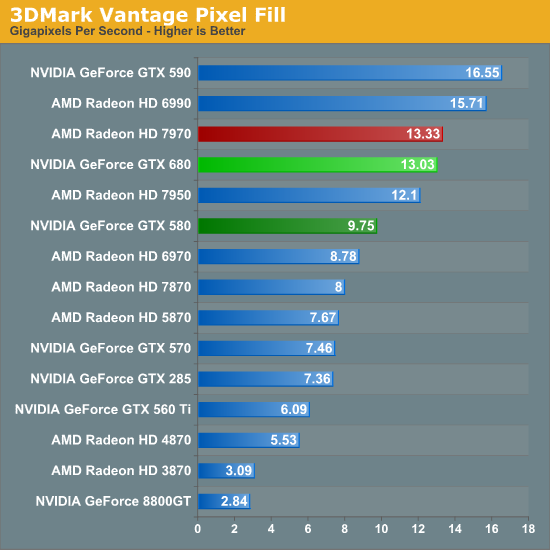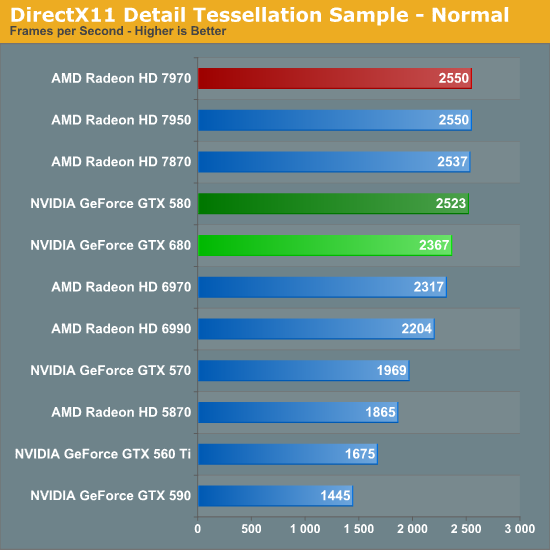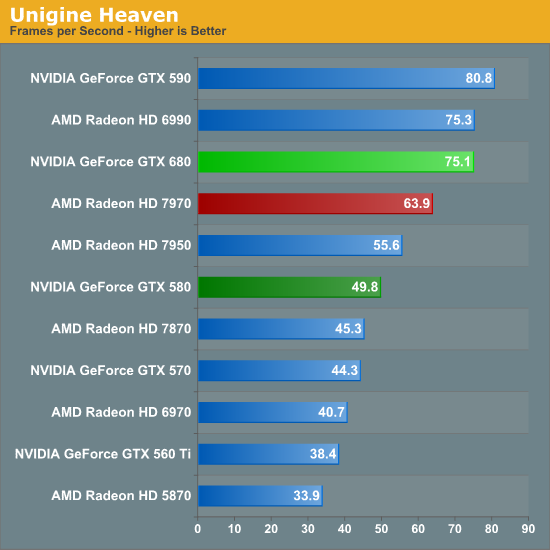NVIDIA GeForce GTX 680 Review: Retaking The Performance Crown
by Ryan Smith on March 22, 2012 9:00 AM ESTTheoreticals
As with any new architecture, we want to take a few moments to look at theoretical performance. These numbers shouldn’t be taken too seriously for cross-vendor comparison, but these numbers often tell us more about interesting architectural improvements that occur from one generation to the next.

Our first theoretical test is perhaps the most perplexing: 3DMark Vantage’s pixel fill test. Typically this test is memory bandwidth bound as the nature of the test has the ROPs pushing as many pixels as possible with as little overhead as possible, which in turn shifts the bottleneck to a mix of ROP performance and the memory bandwidth needed to feed those ROPs.
Compared to the GTX 580, the GTX 680 has almost exactly the same amount of memory bandwidth (192GB/sec) and only 86% of the theoretical ROP performance (37Gpix vs. 32Gpix). In short, it shouldn’t outperform the GTX 580 here, and yet it outperforms the 580 by 33%.
Why does it do this? That’s the hard thing to answer. As we mentioned in our look at GK104’s architecture, NVIDIA did make some minor incremental improvements to their ROPs coming from GF114, such as slightly improved compression and improved polygon merging. One of those may very well be the contributing factor, particularly the compression improvements since this is a typically memory bandwidth bottlenecked test. Alternatively, it’s interesting to note that the difference between the two video cards is almost identical to the difference in the core clock. GTX 560 Ti’s results tend to blow a hole in this theory, but it bears consideration.
In any case, it’s an interesting turn of events and hopefully one that isn’t simply an edge case. As we’ve seen in our benchmarks GTX 680 has strong performance – even if its lead compared to the 7970 diminishes with resolution – but compared to the GTX 580 in particular it needs strong ROP performance across all games in order to deliver good performance at high resolutions and anti-aliasing.

Our second theoretical test is 3DMark Vantage’s texture fill test, which to no surprise has the GTX 680 handily clobbering all prior NVIDIA cards. NVIDIA’s inclusion of 128 texture units on GK104 versus 64 on their previous generation GPUs gives the GTX 680 far better texturing performance. The 30%+ core clock difference only serves to further widen the gap.


Our third theoretical test is the set of settings we use with Microsoft’s Detail Tessellation sample program out of the DX11 SDK. Overall while NVIDIA didn’t make any significant changes to their tessellation hardware (peak triangle rate is still 4/cycle), they have been working on further improving performance at absurdly high tessellation factors. You can see some of this in action at the max factor setting, but even then we’re running into a general performance wall since the Detail Tessellation program can’t go to the absolute highest tessellation factors NVIDIA’s hardware supports.

Our final theoretical test is Unigine Heaven 2.5, a benchmark that straddles the line between a synthetic benchmark and a real-world benchmark as the engine is licensed but no notable DX11 games have been produced using it yet. In any case the Heaven benchmark is notable for its heavy use of tessellation, which means it’s largely a proxy test for tessellation performance. Here we can see the GTX 680 shoot well ahead of the GTX 580 – by more than we saw in the DX11 Detail Tessellation sample – but at the same time there’s a lot more going on in Heaven than just tessellation.
Honestly at this point in time I’m not sure just how much more tessellation performance is going to matter. Until DX11 is the baseline API for games, tessellation is still an add-on feature, which means it’s being used to add fine detail to specific models rather than being used on everything in a game world. This demands good tessellation at high factors but at the same time it’s subject to diminishing returns on the improvement to image quality as triangles reach single pixel sizes and smaller. To that end I’m still waiting to see the day where we see tessellation scale similarly to textures – that is by using full MIP chaining of displacement maps – at which point we can evaluate tessellation performance similar to texture performance when it comes to both measuring the performance hit and evaluating the difference in image quality.










404 Comments
View All Comments
chizow - Thursday, March 22, 2012 - link
Did not see OC results listed anywhere, will they be added to this article or an addendum/supplement later?Ryan Smith - Thursday, March 22, 2012 - link
It will be added to this article. We may also do a separate pipeline article, but everything will be added here for future reference.SlyNine - Thursday, March 22, 2012 - link
Adaptive v-sync, is that like tripple buffering? never heard of it but it sounds interesting.iwod - Thursday, March 22, 2012 - link
In those high res test it seems it is seriously limited by bandwidth. If you could get 7Ghz GDDR5 or MemoryCube i guess it would have performed MUCH better.I think we finally got back to basic. What GPU is all about. Graphics. We have been spending too much time doing GPGPU which only benefits a VERY small percentage of the consumer market.
PeteRoy - Thursday, March 22, 2012 - link
Unfortunately there is no game that can benefit from the power this card has to give.We are in 2012 and the PC gaming graphic level is stuck in the year 2007 with Crysis as the last game to push the limits of video cards.
Since 2006 when the Playstation 3 and Xbox 360 took over the gaming industry all games are made for these consoles therefore all games have the graphic technology of DirectX 9.
Battlefield 3 in the end of 2011 still doesn't look as good as Crysis from 2007.
Sabresiberian - Thursday, March 22, 2012 - link
YOU have no use for this card because you are clearly playing Tetris at 1024x768. Other people have much higher resolutions and play much more demanding games.Some of them even - GASP! - run more than one monitor. Imagine that.
;)
CeriseCogburn - Thursday, March 22, 2012 - link
I agree. The 7970 isn't doing it for me @ 19x12 w SB@4800x4. MOAR.SlyNine - Thursday, March 22, 2012 - link
Crysis 2 will full DX11 plus texture pack tottaly tears my 5870 a new one. unless these cards are now pumping out 3x the FPS than the performance is needed.Ahnilated - Thursday, March 22, 2012 - link
I waited all this time hoping the GTX680's would be an awesome card to upgrade from my GTX480's that I run in SLI. Well I am very disappointed now. I guess I continue waiting.Pessimism - Thursday, March 22, 2012 - link
Do not forget that NVIDIA knowingly and willingly peddled defective chips to multiple large vendors. The real question is whether they have mastered the art of producing chips that will remain bonded to the product they are powering, and whether they will turn to slag once reaching normal operating temperatures.